|
7
THEORETICAL FOUNDATION
2.1 The meaning of shopping mall
To the residents of metropolitan city, the word ‘shopping mall’ sounds very familiar,
since this word can be heard in daily conversation. As living human beings who need to
fulfill daily basic needs such as food and clothes, people purchase those things in a place
called a market.
(Kotler
and
Armstrong,
2004)
defined
a
market as the
set of all actual and potential
buyers of a product or service. These buyers share a particular need or necessity that can
be satisfied through exchange relationships. The size of a market depends on the number
of people who exhibit the need, have resources to engage in exchange, and are willing to
exchange these resources for what they want. The term market stood for the place where
buyers and sellers gathered to exchange their goods. Economists use the term market to
refer
to
a
collection
of
buyers
and
sellers
who
transact
in
a
particular
product
class
(Kotler and Armstrong, 2004).
(Wee, 2005) described the term ‘malls’ as a huge enclosure housing different formats of
retailers, forming ideal shopping destination in Metros, large cities and easily accessible.
The value proposition of malls is variety of shops available close to each other, and all
are under a common roof and uniform shopping environment which is an ideal place for
hangouts.
|
|
8
(Kotler and Armstrong, 2004) defined shopping center as a group of retail businesses
planned,
developed,
owned,
and
managed
as
a unit. A regional shopping
center,
or
regional shopping mall, the largest and most dramatic shopping center, contains from 40
to over 200 stores. Retail is defined as all activities involved in selling goods or services
directly
to
final consumers
for their personal or
non-business
use. Retailer
is business
whose sales come primarily from retailing (Kotler and Armstrong, 2004).
Location is important to shopping mall because it means the shopping mall is where its
target shoppers would like to be. Accessibility of a shopping mall can be measured by
looking at
the ease/difficulty to reach by public
transportation.
Location of a shopping
mall dictates demographics of the area, growth patterns, traffic patterns and competitor’s
location (Marrioti, 2004).
According to (Ahmed, Gingold, Dahari. 2005), shopping malls represent a unique form
of shopping environment, and have become social places where people engage not only
in buying and selling activities but also in social activities, such as going to the cinema,
having
meal,
getting
together
with
friends or
family,
etc.
As
a
result, both
shopping
malls and individual stores must create environment that simultaneously allow people to
shop and be entertained.
With the growth of the malls industry, where various new malls were built and millions
of square feet of retail spaces were added to existing shopping malls each year (Berman
and Evans, 2004), many researches were conducted to deal with different aspects of
shopping malls. The relationship between the malls manager and tenant was one of the
|
|
9
addressed aspects
(Kirkup and
Rafiq,
1994;
Prendargast
et
al., 1996,
1998;
Bruwer,
1997; Addae – Dapaah and Yeo, 1999).
According to Ruiz (1999), some shoppers were attracted to malls purely due to
economic motives; others were attracted due to emotional motives, while multi-purpose
shoppers
had
a
combination
of
these
motives.
For
example
in
Chilly, customers
visit
malls mostly because of purchasing factors, while American customers are more likely
to be leisure-driven, which is around entertainment (Nicholls et al,. 2000). Nicholls et al.
(2000) found that today’s mall patrons tend to be more leisure-driven than shoppers in
the
early
1990s.
Martin
and
Turley
(2004)
analyzed
the
attitudes
of young
segment
(between 19 and 25 years old) towards shopping malls and consumption factors. The
researchers found that young people were more leisure-motivated rather than
purchasing-motivated. Tordkildsen (1992) defined leisure as simply contrast with work,
where leisure is seen as synonymous to recreation or can be also defined as virtually any
satisfying experience. There is an evidence of an increasing proportion of people saying
that they spend time looking around the shops as a leisure activity (Mintel, 2000).
According to LeHew and Fairhurst (2000), shopping center attributes are generally
divided
into
two
groups:
Fixed/long-term and Variable/short
term.
Fixed/long-term
means attributes that can be kept constantly or over a long period of time, which include
location, size, number of car park space, facilities (toilet, escalators, elevators), quality
(design,
shape,
layout,
age),
shopping
atmosphere (lighting, spacious and air-
conditioning),
and
availability
of
other
amenities
(cinema,
food
court, restaurants). In
contrast, short-term attributes are
factors that can be changed
within a short period of
|
|
10
time (one year or less), such as an ideal hangout place with family and friends, flexible
opening
hours,
one-stop shopping,
competition, cleanliness, security,
activities,
events
and promotions and services (Ibrahim et al., 2003).
2.1.2 Shopping mall development in Indonesia
Basically, shopping mall development is similar across Asian countries including in
Jakarta, the capital city of Indonesia, where places for one-stop shopping can be found
especially in Central Business District. Indonesia’s retail growth has become one of the
highest growth rates in Asia. In the first semester of 2007 it reached 17.5%, compared to
11.8 in China, 12% in Philippines, 8.6% in Singapore and 7% in Malaysia. Since 2005
Jakarta has been promoted as a shopping destination to attract overseas shoppers.
Indonesia offers big opportunities for retailers. In other
words, the culture of one-stop
shopping has bombarded the Asian countries.
2.1.3 Indonesian consumers profile
Indonesia is such a huge market for both
domestic and imported goods and services.
Indonesian market is the biggest potential market among ASEAN countries:
•
Indonesian population based on province (according to a survey conducted by a
research company, MARS Indonesia, in January 2009)
|
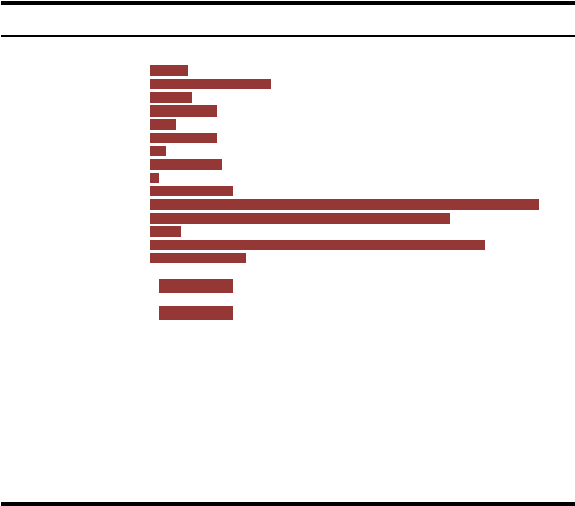 11
Graph 2.1.1: Population of Indonesian consumers based on province
Nanggroe Aceh Darussalam
North Sumatera
West Sumatera
Riau
Jambi
South Sumatera
Bengkulu
Lampung
Bangka Belitung
Island
Jakarta
West Java
Central Java
Yogyakarta
East Java
4,098
4,507
7,181
2,860
7,197
1,750
7,732
1,030
8,929
3,408
(X1000)
13,067
32,341
36,128
41,843
Banten
10,378
Bali
3,553
West Nusa Tenggara
4,632
East Nusa Tenggara
4,360
West Kalimantan
4,695
Central Kalimantan
2,377
South Kalimantan
3,450
East Kalimantan
3,113
North Celebes
2,251
Central Celebes
2,592
South Celebes
Southeast Celebes
2,307
8,884
Gorontalo
900
Maluku
1,351
North Maluku
958
Source: Central Bureau of Statistics
Graph 2.1.1. Shows that West Java
has
the biggest
number of population with
41,834,000 residents.
|
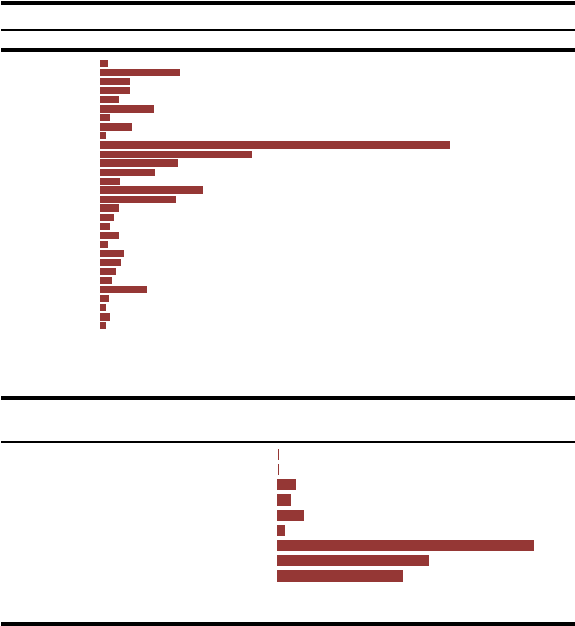 12
Graph 2.1.2: Population of Indonesian Consumers based on City
Band a Aceh
Med
an
Padang
Pekanbaru
Jamb i
200.716
775.209
766.852
487.053
2.055.392
Palemb
ang
Bengkulu
269.091
1.375.765
Band ar Lamp
ung
Pang
kal Pinang
Jakarta
Bodetabek
Band ung
143.963
823.602
1.991.820
3.892.687
8.929.200
Semarang
Yo g yakarta
Surab aya
531.044
1.412.082
2.631.115
Serang
Denp asar
Mataram
Kupang
Po ntianak
Palang
karaya
Banjarmasin
Balikp ap
an
Manad o
Palu
487.419
354.177
274.101
487.039
197.497
608.930
544.602
420.769
315.137
1.951.331
Makassar
Kend ari
Go ro
ntalo
Ambon
Ternate
240.868
148.545
258.619
149.685
1.216.936
Graph 2.1.2. Shows that Jakarta is the most populated city in Indonesia.
Graph 2.1.3: Indonesian Consumers based on Education Level (%)
Post Graduate Degrees (S2/S3)
Undertaking Post Graduate Studies (S2/S3)
University Graduates (S1)
Undertaking Undergraduate Studies (S1)
Diploma/Non-Degree
Undertaking
Diploma
Programs
Senior
High
School
Graduates
Junior High School Graduates
Elementary School Graduates
0.01
0.1
1.9
1.4
2.7
0.8
13.1
15.8
26.7
Source: MARS Indonesia
Graph
2.1.3.
Shows
that
most
of
Indonesian
citizens (26.7%) are
senior
high
school graduates.
|
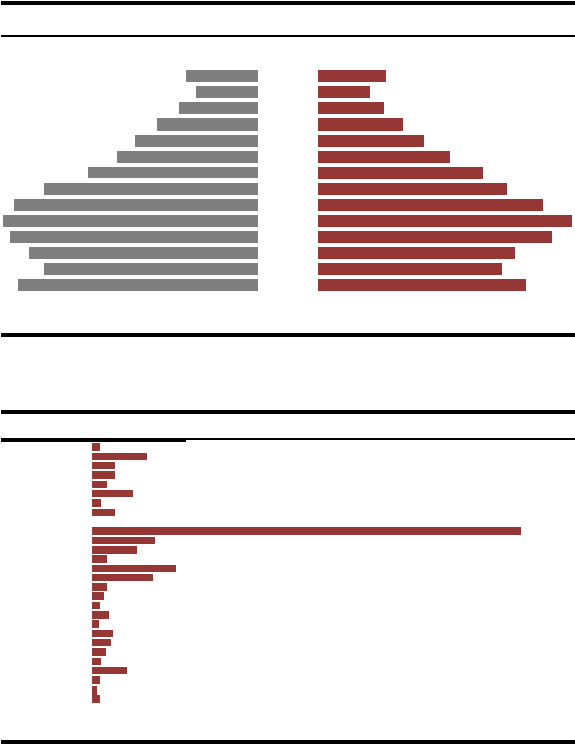 13
Banda Aceh
53.859
Medan
407.428
Padang
170.208
Pekanbaru
167.359
Jambi
107.370
Palembang
303.588
Bengkulu
66.241
Bandar Lampung
174.037
Pangkal Pinang
Jakarta
37.003
Serang
Denpasar
108.755
450.875
Mataram
84.637
Kupang
56.546
Pontianak
124.097
Palangkaraya
48.662
Banjarmasin
151.401
Balikpapan
137.705
Manado
103.561
Palu
65.285
Makassar
257.987
Kendari
57.006
Gorontalo
38.596
Ambon
55.112
Ternate
29.633
Graph 2.1.4: Distribution of Indonesian Consumers based on Age and Sex
Age
960.538
1.098.485
1.142.037
1.114.657
1.027.470
763.707
324.609
277.276
352.307
453.358
551.637
633.717
65+
60 - 64
55 - 59
50 - 54
45 - 49
40 - 44
35 - 39
30 - 34
25 - 29
20 - 24
15 - 19
10 - 14
335.478
259.760
327.738
418.797
520.062
649.277
815.633
931.611
1.110.456
1.250.838
1.155.483
973.079
958.358
5 - 9
908.261
1.077.138
Male
0 - 4
Female
1.025.479
Source: Central Bureau of Statistics
Graph 2.1.4. Shows that most of Indonesian citizens are in their productive age, 20-24
years old.
Graph 2.1.5: Population of Households in Main Cities of Indonesia
Bandung
Semarang
Yogyakarta
Surabaya
467.893
329.544
105.716
625.534
3.199.886
Source: Central Bureau of Statistics processed by MARS
Graphic 2.1.5. Shows that Jakarta is occupied by the largest number of household
population.
|
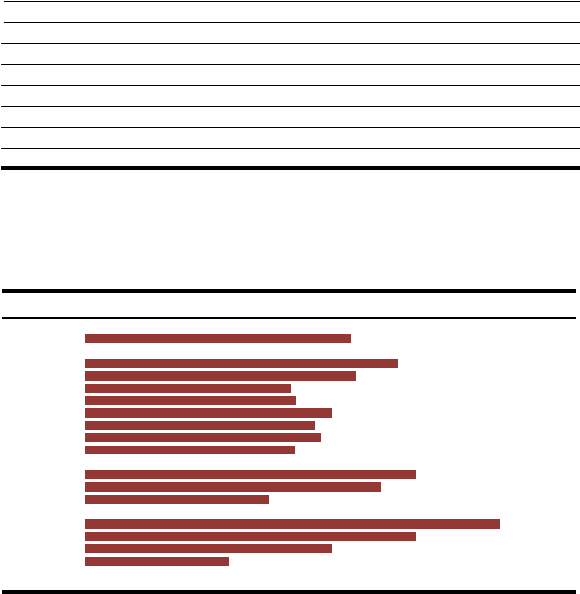 14
Table 2.1.6: Distribution of Indonesian Consumers based on Social-Economic Class
(%)
Social Economic Status
Amount of Expenditure (IDR)
%
E
< IDR 600,000
10.3
D
IDR 600,000 – 900,000
16.7
C
IDR 900,001 – 1,750,000
47.7
B
IDR 1,750,001 – 2,500,000
11.0
A
> IDR 2,500,000
14.3
Source: MARS Indonesia
Table 2.1.6. Shows that
most of
Indonesian citizens are
in status C, which
means that
their expenditure amounts between IDR 900,001 to IDR 1,750,000 per month.
Graph 2.1.7: Visit to Shopping Malls in the last month (%)
Total
43,0
Jakarta
Bandung
Semarang
Surabaya
Medan
Makassar
33,3
34,1
37,1
40,1
43,8
50,6
Balikpapan
Palembang
34,1
38,1
18 - 25 tahun
26 - 34 tahun
35 - 55 tahun
29,8
47,9
53,6
A
B
C
D
&
E
Source: MARS Indonesia
23,3
40,0
53,6
67,2
Graph 2.1.7. Shows that 50.6% of Jakarta citizens visited shopping
malls in last one
month. 53.6% are in age group 18-25 years old and 67.2% are in A social class. These
groups of people are the target market of shopping malls
|
 15
Graph 2.1.8: Frequency of Visit to Shopping Malls in the last month (%)
1x/month
2x/month
3x/month
4x/month
> 4x/month
2.6
10.4
7.7
25.9
53.4
Source: MARS Indonesia
Graph 2.1.8. Shows that 53.4% of Indonesian citizens go to shopping center only once a
month.
Table 2.1.9: Frequency of Visit in the last month based on City (%)
Frequency
1x/month
53.4
58.1
29.7
58.1
39.0
70.3
58.3
47.3
59.6
2x/month
25.9
22.9
36.2
23.8
30.9
24.0
21.4
34.6
26.4
3x/month
10.4
10.9
14.7
8.4
12.0
4.9
8.8
12.1
3.3
4x/month
7.7
5.9
18.1
6.5
10.1
0.5
10.0
3.5
8.8
>
4x/month
2.6
2.3
1.2
3.2
7.9
0.3
1.5
2.5
1.9
Source: MARS Indonesia
Table 2.1.9. Shows 58.1% of Jakarta
residents
visit shopping
mall once a
month and
22.9% of them visit shopping mall twice a month.
|
 16
Table 2.1.10: Frequency of Visit in the last month based on Age (%)
Total
Age groups
Frequency
18 - 25 years
26 - 34 years
35 -
55 years
2x/month
25.9
28.3
26.6
21.5
3x/month
10.4
13.4
9.8
7.0
4x/month
7.7
8.9
7.5
6.6
>
4x/month
2.6
4.4
1.7
1.4
Table 2.1.10. Shows that the younger their age ranges the more frequently people go to
shopping malls and the older their age range the more rarely they go to shopping malls.
It shows that young Indonesian people like to socialize in the mall
Table 2.1.11 : Frequency of Visit in the last month based on Social-Economic Status
(%)
Total
SES
Frequency
A B
C
D & E
1x/month
53.4
49.9
50.4
54.2
62.7
2x/month
25.9
24.7
29.4
26.8
21.9
3x/month
10.4
15.0
7.5
9.5
6.0
4x/month
7.7
7.0
7.9
8.4
7.2
>
4x/month
2.6
3.5
4.8
1.1
2.3
Source: MARS Indonesia
Table 2.1.11 shows
that
most residents across different social-economic status mostly
visited shopping malls only once a month.
|
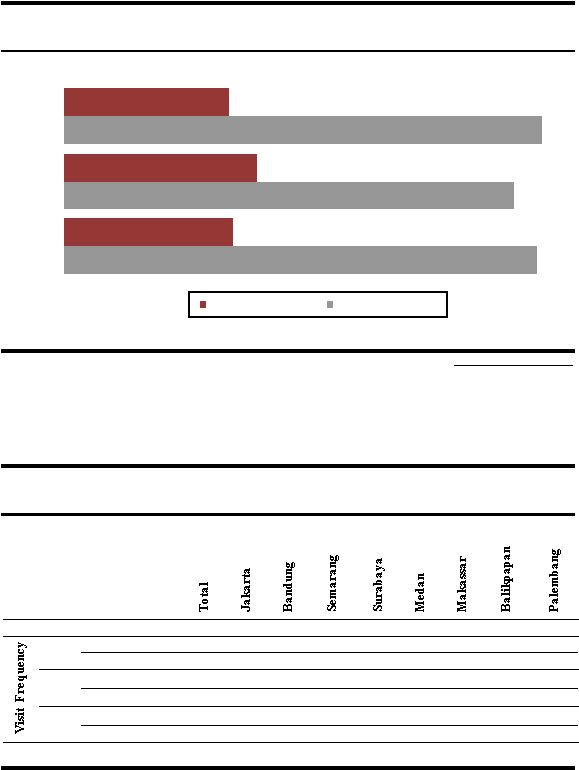 17
Graph 2.1.12: Comparison of Visit Frequency between weekends and working
days (%)
once
twice
>
twice
25.7
30.0
26.4
74.3
70.0
73.6
Working days
Weekends
Source: MARS Indonesia
Graphic
2.1.12
shows
that
most of
Indonesian citizens
do
their
shopping
during
the
weekends
Table 2.1.13: Comparison of Visit Frequency between Working days and
Weekends based on City (%)
Comparison of Visit
Frequency between Working
Days and Weekends
1x
Working Days
25.7
22.8
40.3
26.3
29.2
26.2
27.0
30.4
13.9
Weekends
74.3
77.2
59.7
73.7
70.8
73.8
73.0
69.6
86.1
2x
Working Days
30.0
44.3
20.5
9.8
24.2
20.2
4.5
8.6
20.9
Weekends
70.0
55.7
79.5
90.2
75.8
79.8
95.5
91.4
79.1
> 2x
Working Days
26.4
25.2
13.6
53.3
36.8
35.8
23.5
55.8
16.9
Weekends
73.6
74.8
86.4
46.7
63.2
64.2
76.5
44.2
83.1
Source: MARS Indonesia
Table 2.1.13 Shows that around 75% of Indonesian citizens visit shopping malls during
the weekends.
|
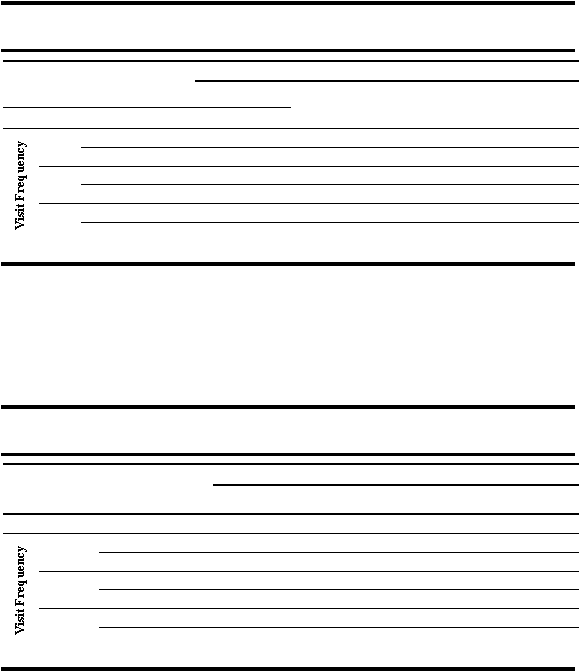 18
Table 2.1.14:
Comparison of Visit Frequency between Working Days and
Weekends based on Age (%)
Comparison of Visit
Frequency between Working
Total
Age Groups
Days and Weekends
18 – 25 years
26 - 34 years
35 -
55 years
1x
2x
> 2x
Working Days
25.7
25.9
27.3
23.1
Weekends
74.3
74.1
72.7
76.9
Working Days
30.0
38.4
19.9
28.9
Weekends
70.0
61.6
80.1
71.1
Working Days
26.4
31.2
29.9
7.5
Weekends
73.6
68.8
70.1
92.5
Source: MARS Indonesia
Table 2.1.14. Shows that based on the age groups
most of of Indonesian citizens
visit
shopping malls during the weekends.
Table 2.1.15:
Comparison of Visit Frequency between Working Days and
Weekends based on Social-Economic Status (%)
Comparison of Visit Frequency
between Working Days and
Weekends
Total
SES
A
B
C
D/E
1x
2x
> 2x
Working Days
25.7
21.8
27.4
29.1
22.6
Weekends
74.3
78.2
72.6
70.9
77.4
Working Days
30.0
43.9
23.7
20.9
23.6
Weekends
70.0
56.1
76.3
79.1
76.4
Working Days
26.4
37.9
40.3
14.3
22.4
Weekends
73.6
62.1
59.7
85.7
77.6
Source: MARS Indonesia
Table 2.1.15. Shows most of Indonesian citizens go to shopping centre during
holiday
|
|
19
2.1.4 Indonesian consumer behavior in general
After being engaged in conducting researches for many years, Handi Irawan, Chairman
of Frontier Consulting Group, has found that Indonesian Customers generally posses the
following characters:
•
Indonesian
customers
are
short-term
minded.
Indonesian customers like to
consume or
use product
fast and everything
instant. That is why ExtraJoss, Hemaviton
Jreng, Indomie are very marketable in Indonesia. However, it is still hard to market
insurance
to
Indonesian
customers
because
most
of
them are
reluctant
to
invest
on
something whose benefit could only be obtained in a decade later. The strategy used to
determine whether Indonesian customers are still short-term minded or not is by offering
them to choose between a discount and a direct gift. Surveys conducted by AC Nielsen
show that 76 % of the customers prefer a discount and only 18 % prefer a direct gift.
• Indonesian customers are dominated
by
unplanned behavior.
This
fact benefits
the
shopping
malls
because
the
longer
the Indonesian
customers
stay
in
a
certain
shopping mall, the more money they would spend. In addition, their buying behavior
often becomes impulsive buying behavior as it is unplanned, an instant decision to buy a
certain product without considering the functional value, but merely for self satisfaction,
excitement, and hedonism while disregarding the post-purchase use of the product
(Rook, 1987).
Indonesian
customers
experience
impulse buying
behavior
during
the discount
season
in
retail
stores,
and
this
may
lead to
unplanned
behavior.
During
the
discount
season,
customers
only
focus on
discounted prices, and become
less
attentive
to any
|
|
20
other
factors which are supposed to be considered in purchasing decision, such as
the
cases that are also experienced by UAE customers.
• Indonesian
customers
love
to
socialize.
The
culture or
the
habit
of
Indonesian
people is to love socializing and gathering
with
informal community
members.
This
is
the
habit of
not only rural residents but also
urban citizens. They tend to
have
very
strong social life. Commonly they share information about anything, including family
life, clothing style, food, cosmetics, health maintenance, etc. During the gathering Word
of Mouth (WOM) communication works effectively.
Vera Tjugiaro batch 2007 conducted a research with 171 respondents, 80.1% of
whom
are
between
20
and
24
years
old.
She
found
that
76.6%
of
their
individual
decision making was influenced by friends. It shows how WOM communication works
among friends.
•
Indonesian customers perceive foreign brand names as high quality. In the mind
of
Indonesian
customers,
foreign
products have relatively higher quality than local
products. They expect that by consuming or
wearing foreign brands they can gain
confidence and prestige. In other words, they do not seem to trust domestic products.
There
are even
some
local
brands which
are still
using
foreign
brand names
(similar
sounds), such as Stanley Adams, Polytron, Detron and Bellagio Deodorant Spray for
Homme. Giving foreign names to those products are the firms’ tactics to make
consumers perceive them as foreign products at a glance.
|
|
21
2.2 Shopping malls across Jakarta
Shopping malls in west Jakarta:
Mall Ciputra
It
was
named
Citraland
Mall,
opened
on
February
26
th
,1993. Owned
by
PT.
Ciputra Property, Tbk., this mall is completed by the existence of Hotel Ciputra
at
the
top building.
It
is strategically
located on
transportation
intersection
in
West Jakarta, and nearby two famous universities, Tarumanegara and Trisakti
Universities. Main tenants of this mall are Matahari Department Store, Gramedia
Bookstore, Gunung Agung Bookstore, 21 cineplex, Hero Supermarket, Gold’s
Gym, McDonald, Starbucks, Pizza Hut and KFC.
Mall Puri Indah
This
mall
is
located
in
Puri
Indah, with
Carrefour
nearby,
and
has
three
department stores, which are Batik Keris, Index and Ace Hardware.
Mall Taman Anggrek
One of top
shopping
malls
in Jakarta, opened
in 1996 as the largest shopping
mall in South East Asia, was designed by American architects, Altoon & Porter.
This mall is owned and managed by Mulia Group, and has
eight residential
towers, with more than 500 specialized stores and two department stores, Metro
and Matahari; Fitness first as its fitness center. Well known flagship stores such
as Zara, Mango, Guess and Aigner
can be found here. This mall is also very
popular for its indoor ice skating rink.
|
|
22
Shopping malls in Central Jakarta:
Plaza Indonesia
Plaza Indonesia is located near the famous landmark, the Selamat Datang
(welcome)
statue.
It
is
owned
by PT.
Global
Mediacom,
Tbk.
(RCTI)
and
Sinarmas Group. It is the first high end shopping mall in Jakarta opened in 1990,
and
amazingly
until
today
it
remains
to be
one of top
shopping
malls
in
the
country. The first flagship Sogo Department Store was opened here as well as
international branded stores, Gucci, Versace, Louis Vuitton, and its latest
flagship store is Zara. The first Debenhams department store was also opened
here.
In
2003,
the
mall
expanded
and
opened
Plaza
Indonesia
Entertainment
Xnter ( EX ).
Entertainment X’nter ( EX )
A
lifestyle
mall
located
in
Plaza
Indonesia
opened
on
February
14
th
, 2004.
Anchored by XXI, Celebrity Fitness, Hard Rock Café and Fashion TV Bar
Grand Indonesia
This mall, opened in 2007, is situated beside
Plaza Indonesia, near Selamat
Datang (welcome) statue. It belongs to PT Djarum, and is set up to become the
Icon of Indonesia retail scene as one of today’s largest upscale shopping mall in
South East Asia. There is also Kempinski Hotel and Residence within. It hosts
Harvey Nichols, Chanel Boutique, Seibu (the Japanese department store), Blitz
Megaplex, and Platinum Fitness First.
Shopping malls in South Jakarta:
Blok M Plaza
|
|
23
The plaza, opened
in 1990,
is
located in Kebayoran Baru. Various snacks and
clothes for daily activities and business attire can be found here.
Cilandak Town Square (Citos)
As the name represents, this mall is located in Cilandak, South Jakarta. Opened
in 2000, CITOS has a number of main tenants, including 21cineplex, Matahari
department store, foodmart and Timezone.
Lifestyle X’nter ( FX )
Located in Sudirman, South Jakarta. It is managed by Plaza Indonesia
Pacific Place
This mall can be considered as one of high end shopping malls, with an
international shopping standard. Opened in November 2007, it is equipped with
Ritz
Carlton
Hotel.
Located
in
Sudirman
Central
Business
District,
the
mall
offers a
lot of
flagship stores such as Bebe, Guess etc. This
high end shopping
mall has five anchor tenants, M Department Store, Kidzania, Kemchicks, Blitz
Megaplex and Best Denki.
Plaza Semanggi
The plaza
is
located
in Semanggi,
with
Balai
Sarbini
function
hall.
There
are
Breadtalk, J.co Donuts & Coffee, Centro Department Store, Starbucks and Planet
Surf in Plaza Semanggi.
Plaza Senayan
One of Jakarta’s premier shopping malls, opened in 1996 is owned by PT
Senayan Trikarya Sempana, the plaza caters two department stores, Metro and
Sogo
department
stores,
and
several boutiques
of
Indonesian
designers
and
international branded stores.
|
|
24
Pondok Indah Mall I & II
This series of malls is one of top shopping malls in Jakarta. PIM I was opened in
the
1980s,
while
PIM
II
was
just
opened
in
2004.
There
are
two
department
stores,
Metro
and
Sogo
department
stores.
PIM
II is completed
with
upscale
designer boutiques. This mall is also popular with expatriates.
Senayan City
This premier mall is located in Senayan and was just opened on June 23®
d
,
2006.
It is anchored by Debenhams department store and Best Denki electronic store. It
also has an apartment tower and a
five-star
hotel operated by Sofitel, a
luxury
hotel
chain.
Senayan
City
represents the
sophisticated
and
modern
Jakarta
lifestyle. It is not designed to be a simple shopping complex, but rather a
manifestation of the city by mixing local and international brands.
Shopping malls in North Jakarta:
Mall Kelapa Gading
It is both a modern shopping mall and an entertainment center. This mall, owned
by PT Summarecon Agung, Tbk., can also be considered as one of
the
largest
shopping mall in Indonesia. It has very complete shop varieties, such as
exclusive
clothing,
teenage shopping area,
wedding shopping
needs,
and
large
varieties of food.
Mall of Indonesia
The mall, built by Agung Sedayu Group, is situated in Kelapa Gading Square
area.
Opened
in
September
2008,
the
mall
is
anchored by
Centro
department
store, Carrefour and Blitz Megaplex. MOI is famous for its small theme park.
Emporium Pluit Mall
|
|
25
This
is a
shopping
center
located
in Pluit. Officially opened
on
January
10
th
,
2009, the mall has two anchor tenants, Carrefour and Sogo. Other tenants include
Gramedia book store, Cinema XXI, Electronic Solution, Zara, Breadtalk, J.Co
Donuts & Coffee, Maystar restaurant and Starbucks.
ITC Cempaka Mas
This trade center has around 6000 kiosks in five floors, is situated nearby
Tanjung
Priok Harbor.
The trade center is
anchored by
Carrefour,
Timezone,
Gramedia and Pizza Hut.
Shopping Mall in East Jakarta :
Tamini Square
Located nearby Taman Mini Indonesia Indah. This shopping mall is anchored by
Carrefour and Ramayana department store
Cibubur Junction
Located
in Cibubur, officially opened on
July 28
th
,
2005. The
mall is anchored
by Matahari department store, Hypermarket and Fitness First.
|
 26
Type of shopping malls in Jakarta :
Trade centers
SHOPPING MALLS
Lifestyle
centers
higher
Regular shopping malls
middle
lower
?
Trade centers are usually
wholesalers’ center
without department store, offer lower
prices goods. ITC Cempaka Mas, ITC Kuningan, ITC Permata Hijau and ITC Kuningan
are trade centers.
?
Lifestyle
centers
in
Jakarta
are
EX
Plaza
Indonesia
and
FX
Sudirman. Those
are
lifestyle malls without department store, they are anchored by Celebrity Fitness and have
cafes and restaurants
?
Regular
shopping malls are common shopping
malls
with department store, can be
found in business districts in Jakarta. Debenhams, Sogo and Seibu are department store
in regular higher level shopping malls. Regular middle level shopping malls are
anchored by Metro Department store.
Cahaya, Yogya, Matahari and Robinson
Department store can be found
in
regular lower class shopping
malls.
Regular
higher
level shopping malls are equipped with food court, restaurants, cafes and theatre. Those
are perfect for social gathering places.
|
|
27
2.2.2 Shopping experience
Shopping experience must be a pleasurable experience and comfort the customers during
their shopping in a certain shopping center. According to (
Ahmed, Gingold,
Dahari.
2005 ), mall management (and mall-based retailers) must now offer something extra to
lure shoppers,
whether
it is a unique experience, entertainment, excitement or a social
gathering place. Although today shopping malls have indirect competitors such as online
shopping, catalogs and home shopping on television that offer practicality, those kinds
of
shopping
could
only compliment
them but
can
never
really
replace
real
“live”
shopping malls.
The spectacular Mall of America contains more than 520 specialty stores, 49 restaurants,
indoor
theme parks, an Underwater World featuring
hundreds of marine
specimens, a
dolphin show and a two-story miniature golf course, all of which can offer an
unforgettable shopping experience which is hard to be copied by any competitor.
In Jakarta, Mall of Indonesia has been designed to attract visitors in the same way as the
Mall of America. It is facilitated with a small theme park and many kinds of fun family
entertainment.
Shopping must be pleasurable or a leisure experience. Today’s customers are more
discerning,
less
loyal
and
more
demanding.
Demand
for
experience
is
viewed
very
highly that malls need to provide more authentic retail brands with clearer relationships
with
the
shoppers.
Berry
et
al.
(1997)
stated that
“fun”
must
become
an
important
consideration to successful retailer value propositions.
|
|
28
Obviously, today’s customers are seeking value, choices and customer experience.
Therefore, current retailers of shopping malls should:
• ©reate a theatrical retailing environment;
• stress fun, excitement and entertainment;
• encourage greater customer participation in the retail service experience (Baron et al.,
2000; Mathwick et al., 2001). To deal with those three things, shopping mall
managers
must pay attention
to
ambient conditions and environmental aspects that
can irritate shoppers.
Ambient conditions which can create the following problems (Lovelock et al, 2005):
• the shopping mall is inadequate of cleanliness
• toilet is neither spacious nor clean;
• inadequate Air Conditioning;
• the music inside the shopping mall is too loud;
• There is bad smell in the shopping mall.
Environmental aspect problems include (Lovelock et al, 2005):
• direction within the shopping mall is inadequate;
• shopping mall does not have good landscape may cause difficulty in finding certain
stores or products;
• inadequate security;
• inadequate escalators and elevators within the shopping mall;
• inadequate parking space;
• Hard to be reached by public transportation.
|
|
29
2.2.3 Behavioral Intentions.
Shopping mall managers must be able to motivate all shoppers’ spending behavior in
order to
grab
more
profits.
This
can be achieved
by
maintaining
loyal
patronage
and
generating positive “Word Of Mouth” (known as the cheapest, fastest and most effective
way to recruit new shoppers).
Soderlund and Ohman (2005) found intentions-as-expectations and intentions-as-wants
are
interrelated
with both customer satisfaction and repatronizing behavior. ( Babin et
al., 1994) cited that individuals generally shop to obtain hedonic and/or utilitarian
values. Utilitarian consumption is when the products are consumed to accomplish a
specific function or a need, whereas hedonic consumption is when the products are
consumed for fun, pleasure and excitement (Rook, 1987 ). Therefore, a shopping mall
would be more profitable and favorable if it could serve and satisfy both types of
shoppers.
When a shopping mall is perceived as exciting, consumers may visit it more frequently
and be less likely to visit other shopping malls (Lumpkin et al., 1986).
2.8 Segmentation Approach
In the past, a research identifying attractiveness factors of shopping malls assumed that
consumers
were homogeneous
in their choice of mall. This assumption contradicts
the
fact
that
consumers
are
different,
and
therefore,
the
market
needs
to
be
segmented
(Suarez et al., 2004). Suarez analyzed different segments of consumers in their shopping
centre
choices.
Boedeker
(1995)
segmented shoppers
into
two
types,
the
“new
type
|
|
30
shoppers” who value both recreational and economic purpose of a shopping mall and the
“traditional shoppers” who got much lower attraction on the recreational aspects.
In the main journal entitled Shopping mall attractiveness: a segmentation approach, (El-
Adly, 2006) segmented shoppers into the following three segments:
•
Relaxed
shoppers,
who
mostly
do
their
shopping
in
the
weekends. This
type
of
segment
mostly concern about comfort,
mall essence and convenience. They prefer
going to shopping malls which provide comfortable seating and rest areas, ample
parking
and safety to enable shoppers to
spend
time
or to
socialize
within
the
shopping malls. In addition, they also concern about store variety, products’ quality,
after sales service, while
they
have
less concern about entertainment, diversity and
luxury of shopping mall. To attract this segment shopping malls should be equipped
with complete supermarkets, good directions inside the mall, shuttle bus service even
good access to reach the mall. However, entertainment, diversity and luxury of
shopping mall are not their priority.
•
Demanding shoppers. Generally, demanding shoppers are a segment of young
people. They have a greater consideration
on entertainment, diversity
and
luxury
rather
than
the
other
two
segments.
They also
have
a
stronger
desire
to
stay
in
shopping malls. Thus, the shopping mall management needs to make this segment
feel
comfortable
to stay
long
in
the
mall,
which
will
automatically
lead
them
to
spend more.
|
|
31
•
Pragmatic
shoppers. This
segment
only concerns
about
the mall
essence
factor. To
them,
products
quality,
appropriateness
of
prices
to
their
income
and
variety
of
stores are very important as they tend to compare prices and quality. Shopping malls
and retailers could offer gift with purchase, quantity discount and gift voucher with a
minimum purchase. To this segment, the entertainment factor is not important when
choosing
a
shopping
mall.
The
existence
of
a
large
food
court, the
presence of a
cinema and
the popularity of
the shopping
mall are
viewed as not
important
from
this segment’s point of view.
|